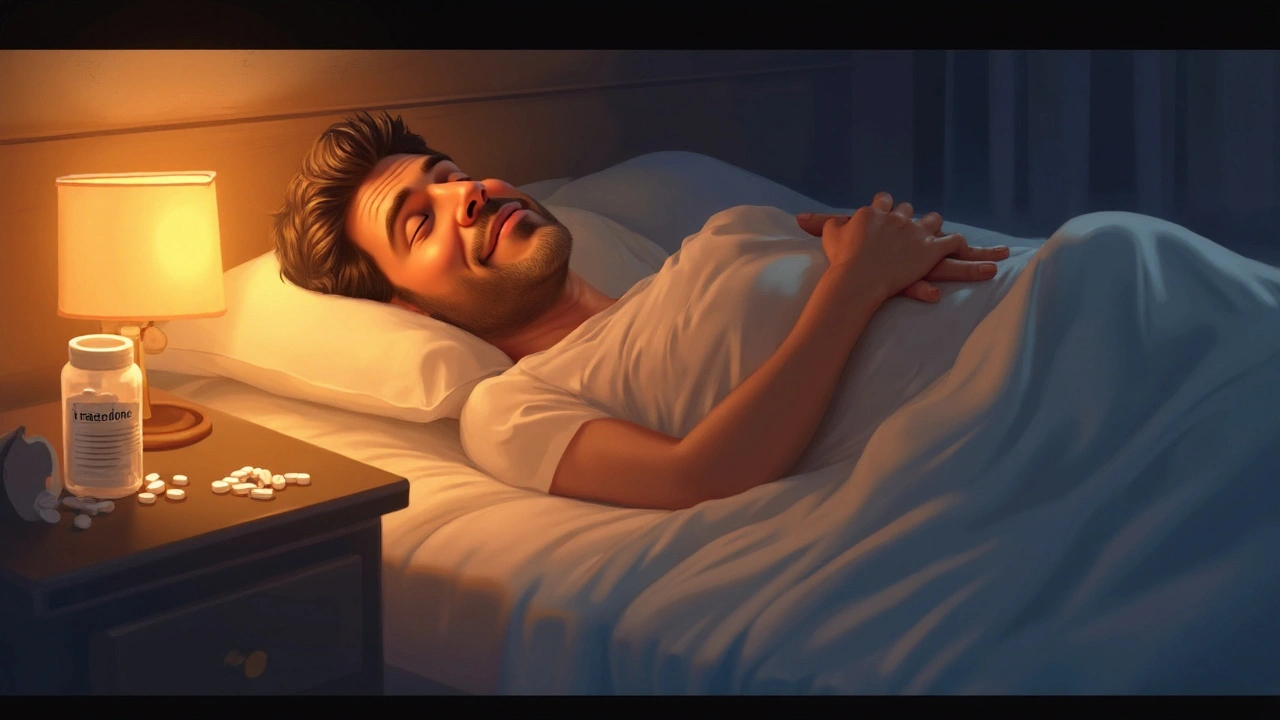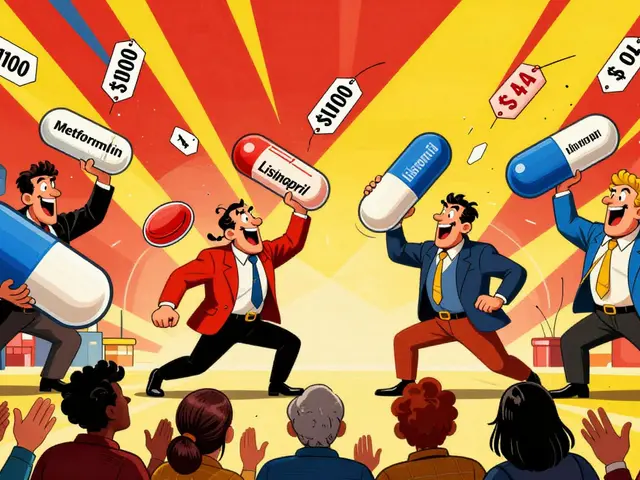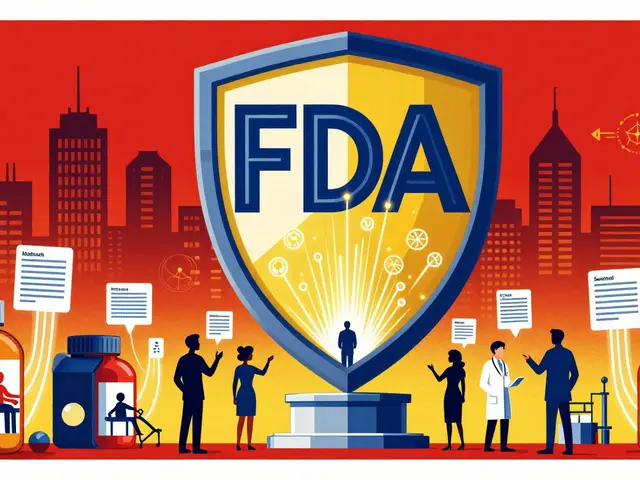Sleep & Mood Medication Selector
Primary Concern
Sleep Pattern
Medical History
Side Effect Tolerance
Recommended Medication:
Why This Choice:
Trazodone is a serotonin antagonist and reuptake inhibitor (SARI) that’s prescribed for depression and off‑label for insomnia. It works by boosting serotonin levels while blocking certain serotonin receptors, producing a calming effect that helps people fall asleep without the classic “hang‑over” of many hypnotics.
Why People Turn to Trazodone
Clinicians often reach for Trazodone when a patient needs a medication that can handle both mood and sleep. Its half‑life ranges from 5 to 13 hours, meaning it covers a typical night’s sleep without lingering sedation. Doses for insomnia start as low as 25mg at bedtime, while depression treatment usually begins at 150mg daily, adjusted upward.
Key Alternatives to Consider
Below are the most common drugs patients compare with Trazodone. Each brings a different mechanism, side‑effect profile, and dosing routine.
Sertraline is a selective serotonin reuptake inhibitor (SSRI) primarily used for depression, anxiety, and PTSD. Unlike Trazodone, it’s not sedating, so it’s rarely used as a sleep aid.
Venlafaxine is a serotonin‑norepinephrine reuptake inhibitor (SNRI) that treats major depressive disorder and generalized anxiety. It can cause insomnia at higher doses, making it the opposite of a sleep‑friendly option.
Mirtazapine is a noradrenergic and specific serotonergic antidepressant (NaSSA) known for its strong sedative effect. It’s a popular nighttime antidepressant because it promotes sleep while treating mood.
Zolpidem is a non‑benzodiazepine hypnotic (a “Z‑drug”) approved for short‑term insomnia. It works fast, but tolerance and next‑day drowsiness are common concerns.
Melatonin is a hormone supplement that regulates the sleep‑wake cycle. It’s over‑the‑counter, has minimal side effects, and is best for circadian rhythm disorders rather than severe insomnia.
Clonazepam is a benzodiazepine used for anxiety, seizure disorders, and as a short‑term sleep aid. It carries a high risk of dependence, making it a last‑resort option.
Quick Comparison Table
| Drug | Primary Indication | Mechanism | Typical Bedtime Dose | Onset of Sleep Aid | Half‑Life | Common Side Effects |
|---|---|---|---|---|---|---|
| Trazodone | Depression (off‑label insomnia) | SARI - serotonin blockade + reuptake inhibition | 25-100mg | 30‑60min | 5‑13h | Drowsiness, dry mouth, orthostatic hypotension |
| Sertraline | Depression, anxiety | SSRI - serotonin reuptake inhibition | - (not a sleep aid) | - | 26h | GI upset, sexual dysfunction, insomnia |
| Mirtazapine | Depression (nighttime) | NaSSA - alpha‑2 antagonism, H1 blockade | 15‑30mg | 15‑30min | 20‑40h | Weight gain, sedation, increased appetite |
| Zolpidem | Acute insomnia | GABA‑A receptor agonist (Z‑drug) | 5‑10mg | 15‑30min | 2‑3h | Memory impairment, next‑day grogginess, rare dependence |
| Melatonin | Circadian rhythm disorders | Hormone supplement - regulates clock genes | 0.5‑5mg | 30‑60min | 30‑50min (metabolized quickly) | Headache, dizziness, rare vivid dreams |
| Clonazepam | Anxiety, seizures, short‑term insomnia | Benzodiazepine - enhances GABA activity | 0.5‑1mg | 15‑30min | 30‑40h | Dependence, withdrawal, daytime sedation |
TL;DR - What You Need to Know
- Trazodone offers combined mood and sleep benefits with a moderate half‑life.
- For pure insomnia, Zolpidem or melatonin act faster but lack antidepressant effects.
- Mirtazapine provides strong sedation and depression relief but often causes weight gain.
- SSRIs like sertraline treat depression well but may worsen sleep.
- Benzodiazepines (clonazepam) are potent sleepers but carry high dependence risk.

How to Choose the Right Agent
Think of your decision as a two‑step filter: first, clarify the main clinical goal, then weigh safety and convenience.
- Primary problem: Is insomnia the chief complaint, or is depression the driver?
- Sleep pattern: Do you need a rapid‑onset hypnotic for occasional sleepless nights, or a nightly sedative that also lifts mood?
- Medical history: Liver disease, cardiovascular issues, or a history of substance use will tip the scales away from certain drugs.
- Side‑effect tolerance: Weight gain may be acceptable for some, but not for others; next‑day grogginess can be a deal‑breaker for shift workers.
- Regulatory status and cost: Prescription‑only agents (Trazodone, Zolpidem) require a doctor visit, whereas melatonin is OTC and typically cheaper.
Match your answers against the table above, and you’ll land on a shortlist that fits your lifestyle.
Real‑World Scenarios
Scenario A - Young adult with major depressive disorder and mild insomnia: A psychiatrist might start sertraline for mood and add low‑dose Trazodone at night to smooth sleep. The combination covers both fronts without compromising daytime alertness.
Scenario B - Elderly patient with hypertension and chronic insomnia: Trazodone’s orthostatic hypotension risk may be too high. A low dose of melatonin or a short course of Zolpidem (under strict monitoring) could be safer.
Scenario C - Shift‑worker who struggles with circadian misalignment: Melatonin timed to the desired bedtime is the first line, while a nightly mirtazapine dose can double‑up as a mood stabiliser if depression is also present.
Potential Pitfalls and How to Avoid Them
- Dosage confusion: Trazodone for insomnia uses far lower doses than for depression. Prescribing 150mg at bedtime can cause morning grogginess.
- Drug interactions: Trazodone is metabolized by CYP3A4; concurrent use of strong inhibitors (ketoconazole, erythromycin) can raise levels and increase side‑effects.
- Withdrawal concerns: Abruptly stopping benzodiazepines like clonazepam triggers seizures. Taper slowly over weeks.
- Long‑term safety: Chronic high‑dose Zolpidem has been linked to rare complex sleep behaviors (sleep‑driving). Use the lowest effective dose.
Related Concepts and Next Steps
Understanding Trazodone’s place in therapy also touches on broader topics such as serotonin physiology, the role of hepatic metabolism in drug selection, and non‑pharmacologic sleep hygiene. Readers interested in digging deeper might explore:
- How CYP3A4 polymorphisms affect antidepressant dosing.
- Evidence‑based cognitive‑behavioral therapy for insomnia (CBT‑I) as a partner to medication.
- Comparing antidepressant classes: SSRIs vs. SNRIs vs. SARIs.
These areas round out a holistic approach to mood and sleep management.
Frequently Asked Questions
Can Trazodone be used as a first‑line sleep aid?
Yes, many clinicians prescribe low‑dose Trazodone (25‑50mg) as a first‑line option for patients who need both sleep support and a mild antidepressant effect. It’s attractive because it’s not a controlled substance and carries a low risk of dependence compared with benzodiazepines.
How does Trazodone differ from Zolpidem?
Trazodone works on serotonin pathways and has a longer half‑life, making it suitable for ongoing mood management. Zolpidem targets GABA‑A receptors, acts quickly, and is intended for short‑term insomnia only. Zolpidem’s rapid onset can cause next‑day grogginess, while Trazodone’s sedation is more gradual.
Is Trazodone safe for people with heart problems?
Trazodone can cause orthostatic hypotension, which may aggravate existing cardiac conditions. Doctors usually start at the lowest dose and monitor blood pressure, especially in older adults or those on antihypertensives.
What are the biggest side effects of Mirtazapine compared to Trazodone?
Mirtazapine is notorious for weight gain and pronounced sedation due to its antihistamine action. Trazodone’s side‑effects are typically dry mouth and mild dizziness. If a patient is concerned about gaining pounds, Trazodone is usually the gentler choice.
Can I combine Trazodone with melatonin?
Combining low‑dose Trazodone with melatonin is generally safe and can improve sleep onset for people with circadian rhythm disruptions. However, both agents can increase sedation, so it’s wise to start with the lowest melatonin dose (0.5mg) and watch for excessive drowsiness.






Zac James
September 25, 2025 AT 21:13Thanks for laying out the options so clearly; it’s helpful to see side‑effects and dosing side by side. I appreciate the mix of pharmacologic detail and practical tips on when to consider each drug. For anyone juggling insomnia and low‑grade depression, the low‑dose Trazodone chart is especially useful. It makes the decision feel less like a gamble and more like an informed choice.
Arthur Verdier
September 29, 2025 AT 08:33Oh great, another glossy pharma pamphlet trying to convince us that a SARI is the magical silver bullet for sleep. As if the “low dependence” brag isn’t just a marketing spin for the same old side‑effects. Don’t forget the orthostatic hypotension that can turn a bedtime routine into a midnight wobble. Sure, pop a pill and hope your heart doesn’t file a complaint.
Breanna Mitchell
October 2, 2025 AT 19:53Reading through the table gave me a lot of confidence to talk to my doctor about trying a low dose of Trazodone. I’ve been hesitant because of weight‑gain fears, but seeing the comparison with Mirtazapine helped put things in perspective. It’s reassuring to know there are alternatives that don’t carry that particular side‑effect. I’m feeling hopeful about finally getting some decent rest.
Alice Witland
October 6, 2025 AT 07:13While the enthusiasm is commendable, let’s not overlook that the article’s “low‑dose” claim still ranges up to 100 mg, which for some can be borderline high. Precision matters: “low‑dose” should be explicitly defined, otherwise readers might assume 25 mg is universal. A touch of nuance would elevate the guidance from hopeful to reliably accurate.
Chris Wiseman
October 9, 2025 AT 18:33One cannot simply treat the pharmacological landscape as a binary switch between “good” and “bad” without acknowledging the ontological complexity inherent in psychopharmacology. The premise that Trazodone occupies a middle ground between hypnotics and antidepressants invites a dialectical examination of how we, as a culture, compartmentalize mental health interventions. First, the molecule’s dual action on serotonin receptors creates a cascade that blurs the line traditionally drawn between mood elevation and sleep induction, thereby challenging the reductionist view espoused by many prescribers. Second, the historical context-originally synthesized in the 1960s as an antipsychotic-reveals an evolutionary pathway that mirrors our own shifting attitudes toward off‑label usage. Moreover, the comparative table, while comprehensive, inadvertently tacitly endorses a hierarchy that places newer agents like Zolpidem on a pedestal of “rapid onset” without sufficiently critiquing the long‑term neurocognitive risks. Third, the emphasis on side‑effect profiles, such as orthostatic hypotension, should be juxtaposed with the subtle yet pervasive phenomenon of daytime sedation that can erode functional capacity. In addition, the metabolic considerations-particularly CYP3A4 interactions-underscore the necessity for a personalized, rather than a one‑size‑fits‑all, prescribing ethos. Fourth, the article’s omission of non‑pharmacologic interventions, such as cognitive‑behavioral therapy for insomnia, perpetuates a pharmaceutical centrism that may not serve all patients. Fifth, the notion of “dependence risk” as a binary attribute overlooks the spectrum of psychological reliance that can develop even with low‑dose regimens. Sixth, the financial dimension, including insurance coverage disparities, remains an underexplored variable influencing patient choice. Seventh, the narrative surrounding weight gain associated with Mirtazapine, while accurate, fails to acknowledge that a subset of patients actually experience appetite suppression. Eighth, the pharmacokinetic half‑life discussion would benefit from a deeper dive into active metabolites that may prolong pharmacodynamic effects beyond the reported window. Ninth, the recommendation hierarchy could be refined by integrating patient‑reported outcome measures rather than relying solely on clinician‑driven metrics. Tenth, the article’s tone, at times, adopts a paternalistic stance that could alienate readers seeking collaborative decision‑making. Lastly, the sheer volume of information presented, while impressive, risks overwhelming laypersons; a succinct, tiered summary could bridge the gap between thoroughness and accessibility. All these considerations, taken together, illuminate the intricate tapestry of factors that should inform any rational selection of a sleep or mood aid.
alan garcia petra
October 13, 2025 AT 05:53Great rundown! I’ll definitely bring this up at my next appointment. Knowing there’s a low‑dose option that won’t keep me glued to the pillow in the morning feels like a win. Thanks for making the science feel doable.
Allan Jovero
October 16, 2025 AT 17:13While the sentiment is appreciated, it would be prudent to note that “low‑dose” should be quantifiably specified to avoid ambiguity. In academic writing, clarity regarding milligram ranges is essential for reproducibility. The current phrasing might mislead a reader unfamiliar with dosage conventions.
Andy V
October 20, 2025 AT 04:33Ambiguity persists despite your clarification.
Tammie Sinnott
October 23, 2025 AT 15:53Let’s get something straight: the “quick fix” claim for Zolpidem is not a free pass to treat chronic insomnia. You can’t just pop a Z‑drug every night without courting tolerance and bizarre nocturnal behaviours. The article smartly mentions next‑day grogginess, but it doesn’t scream loud enough about the rare sleep‑driving episodes that have landed people in police reports. Plus, the weight‑gain warning on Mirtazapine is more than a footnote-it’s a major compliance issue for many patients. Bottom line, no single pill is a miracle; you have to weigh the trade‑offs.
Michelle Wigdorovitz
October 27, 2025 AT 02:13Absolutely, the trade‑offs are the crux of any medication decision. It’s fascinating how each drug’s side‑effect profile reflects its underlying pharmacology-Zolpidem’s GABAergic action brings that rapid onset but also the potential for complex sleep behaviors. Meanwhile, the antihistaminic bliss of Mirtazapine, though effective for sleep, inevitably nudges the appetite scale upward. Your point about chronic use is spot‑on; clinicians should treat “quick fix” as a bridge rather than a long‑term solution.
Arianne Gatchalian
October 30, 2025 AT 13:33I hear you, and it’s reassuring to see the emphasis on a balanced perspective. When discussing options with patients, highlighting both efficacy and the lifestyle impact, like weight changes or morning alertness, can foster shared decision‑making. Thanks for shedding light on the nuanced trade‑offs.
Sen Đá
November 3, 2025 AT 00:53The exposition presents a comprehensive comparative framework, yet certain terminological inconsistencies merit correction. For instance, the designation of Trazodone as a “SARI” should be accompanied by its full appellation to aid readers unfamiliar with the acronym. Additionally, the phrase “next‑day grogginess” could be refined to “residual sedation” to maintain clinical precision.
LEE DM
November 6, 2025 AT 12:13Appreciate the detail‑oriented feedback; the full term “serotonin antagonist and reuptake inhibitor” indeed clarifies the class for a broader audience. I’ll incorporate “residual sedation” in future revisions to keep the language both accurate and accessible.
mathokozo mbuzi
November 9, 2025 AT 23:33From an inquisitive standpoint, the interplay between hepatic metabolism and benzodiazepine half‑life invites deeper discussion, especially in populations with compromised liver function. It would be valuable to see a section addressing dose adjustments in such scenarios.
Penny X
November 13, 2025 AT 10:53Indeed, the hepatic considerations are paramount; failure to adjust dosing in the presence of CYP3A4 inhibition can precipitate toxic accumulation. A rigorous protocol for liver‑function‑based titration should be standard practice.
Amy Aims
November 16, 2025 AT 22:13Thanks for the thorough insight! 😊 It’s great to have a clear reminder about liver health when tweaking meds.